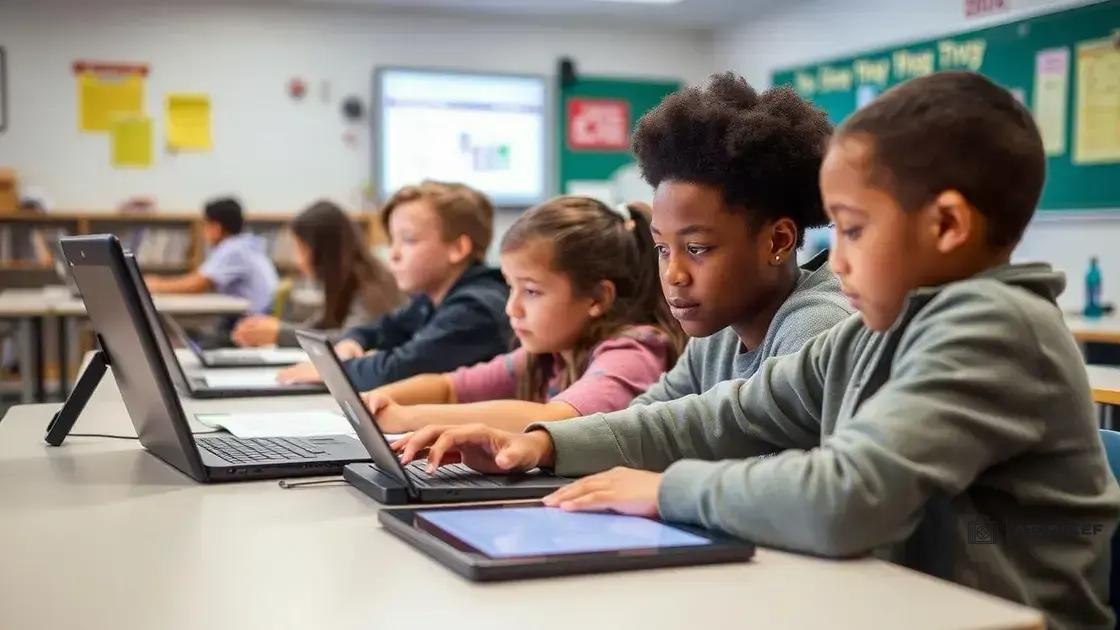Education policy under Trump’s administration: a comprehensive overview

Education policy under Trump’s administration focused on expanding school choice through charter schools and vouchers, sparking debates about funding disparities and the impact on public school resources and student performance.
Education policy under Trump’s administration brought about significant transformations in how schools operate. Curious about what changed and how it affects students today? Let’s dive into the intricacies of this topic.
Key changes to education policy
During Trump’s presidency, several key changes to education policy emerged that reshaped the educational landscape in America. Understanding these changes is crucial for grasping their implications on students, teachers, and schools.
Shift in Funding Priorities
One of the most significant alterations was the emphasis on school choice. The administration promoted charter schools and voucher programs, aiming to provide parents with options outside of public schools. This shift raised critical discussions about how funds are allocated.
- Increased funding for charter schools.
- Vouchers for private school education.
- Reduction in state funding for traditional public schools.
Such funding priorities sparked debates about their effectiveness and fairness. Critics argued that these policies could lead to inequities, leaving most public schools underfunded. Meanwhile, supporters cited the opportunities these changes could create for families seeking quality education.
Promoting Federal Oversight
Another notable change was the reduction of federal oversight. The Every Student Succeeds Act (ESSA) enabled states to have more control over educational standards. However, this resulted in varied implementations across states, leading to disparities in educational quality.
With less federal guidelines, states faced the challenge of adequately measuring student performance and addressing achievement gaps. Parents and educators had mixed feelings regarding this newfound freedom. On one hand, it allowed for more tailored approaches to education; on the other, it also raised concerns about accountability and consistency.
Overall, the changes made during Trump’s administration reflect a shift toward a more market-driven approach in education. These policies continue to influence discussions on educational reform, highlighting the ongoing debate over the best paths to improved student outcomes.
Impact on public school funding
The impact on public school funding during Trump’s administration brought significant changes that affected many districts across the country. These changes shifted how resources were allocated and who benefited from them.
Reduction in Federal Support
One of the most notable effects was the reduction of federal support for public schools. Many districts relied on federal funding to help maintain programs and support students in need. With less money coming from the federal level, schools faced tough choices.
- Programs for low-income students were at risk.
- Support services for special education began to diminish.
- Teachers faced challenges in obtaining necessary materials.
This reduction meant that some schools struggled to provide a quality education. The lack of resources had a direct impact on classroom sizes and educational materials, often leading to larger classes and outdated textbooks.
Increased Focus on Voucher Programs
The Trump administration also pushed for more school choice through voucher programs. These programs allowed funds to follow students to the schools of their choice, including private institutions. This shift drew attention away from public schools, leading to concerns about equity.
As more funds were directed towards vouchers, public schools noticed further declines in their financial support. Funding that could have gone to enhance public education was now being utilized elsewhere, which raised questions regarding the long-term effects on the public school system.
Districts that were already struggling found themselves in even more challenging positions, unable to compete with private institutions that had access to greater resources. This situation sparked debates among policymakers, educators, and parents about the future of education funding in America.
The role of school choice

The role of school choice during Trump’s administration played a significant part in shaping education policies. School choice allows parents to select the best educational environment for their children, which could include public, charter, or private schools. This concept gained traction in recent years and has been a focal point of many education debates.
Expansion of Charter Schools
One major aspect of school choice was the expansion of charter schools. These schools are publicly funded but operate independently from traditional school districts. This independence allows them to implement innovative teaching methods and curricula.
- Charter schools often have more flexibility in hiring teachers.
- They can create specialized programs tailored to student interests.
- They are subject to less regulation than traditional public schools.
While charter schools provide alternatives for families, critics argue that they can divert funding away from public schools, leading to resource shortages.
Voucher Programs
Another critical component was the introduction of voucher programs. These programs give families financial assistance to enroll their children in private schools. For many families, this can open doors to educational opportunities they may not afford otherwise.
However, voucher programs are controversial. They often raise questions about equity, as not all families have equal access to options. Furthermore, using public funds for private education sparks discussions about how to best allocate resources for public schooling. Teachers and education advocates point out that the focus should instead be on improving public schools for every child.
Despite these controversies, the idea of school choice continues to gain support from various groups who believe it fosters competition and encourages innovation in education, potentially leading to better outcomes for students.
Effects on student performance
The effects on student performance due to the education policies during Trump’s administration have been a topic of much discussion. Changes like increased school choice and funding disparities greatly influenced how students learn and achieve.
Impact of School Choice
School choice initiatives aimed to give families more options, but the actual impact varies widely. Many families found that charter schools and voucher programs did not necessarily lead to better student performance. Studies showed mixed results, with some students thriving while others struggled.
- In some regions, students in charter schools outperformed their peers in traditional public schools.
- However, other reports indicated little difference in achievement levels.
- The effectiveness of these schools often depended on local conditions and resources.
As families chose different types of schools, the competition increased, leading some public schools to rethink their strategies in order to retain students.
Resource Allocation and Its Role
The distribution of resources also played a significant role in student performance. Schools that faced budget cuts struggled to provide adequate support. Teachers reported concerns about larger class sizes and insufficient materials, which hindered their ability to assist students effectively. These issues contributed to a decrease in student engagement and overall performance.
While some students adapted, others faced challenges that limited their academic growth. This situation raised questions about equity in education. Students in underfunded schools may not receive the same opportunities as those in more affluent areas.
Overall, the policies enacted during this period highlighted the complex relationship between education funding, school choice, and student outcomes, emphasizing the need for a balanced approach to reform.
Criticism and support of policies
The criticism and support of education policies during Trump’s administration have generated significant debate. Various stakeholders—educators, parents, and policymakers—have expressed diverse opinions about these changes.
Support for School Choice
Many supporters hailed the expansion of school choice. They argued that it provided families with more options to find suitable educational environments for their children. Proponents emphasized that this flexibility could lead to higher student achievement and greater parental involvement.
- Supporters believe that competition among schools can drive improvements.
- Advocates argue that families should have the freedom to choose the best fit for their child’s learning style.
- School choice can empower low-income families to access better educational opportunities.
This belief in school choice has grown over the years, making it a central issue in educational reform discussions.
Criticism from Educators
On the other hand, many educators and critics voiced concerns about the negative consequences of these policies. Critics argued that focusing on school choice diverted necessary funding and attention from traditional public schools. They worried this could lead to further inequities in the education system.
Some of the main points of criticism included:
- State funds being redirected away from underfunded public schools.
- Increased segregation of students based on socioeconomic status.
- Challenges in accountability for charter and private schools.
Opponents of these policies called for a more balanced approach that supports all schools rather than favoring certain types over others. They believed that improving public education should be the primary goal. This ongoing debate continues to shape discussions about the future of education policy in the United States.
FAQ – Questions About Education Policy Under Trump’s Administration
What are the main goals of school choice policies?
The main goals are to provide families with more options for their children’s education and to encourage competition among schools to improve performance.
What criticisms do public schools face due to school choice?
Critics argue that school choice diverts funds from public schools, which can lead to resource shortages and increased inequality.
How has student performance been affected by these policies?
Student performance has shown mixed results, with some studies indicating improvements in charter schools, while others point to ongoing challenges in public schools.
Why is equity in education a significant concern?
Equity is crucial because all students deserve access to quality education, regardless of their background, which school choice policies may not fully support.





